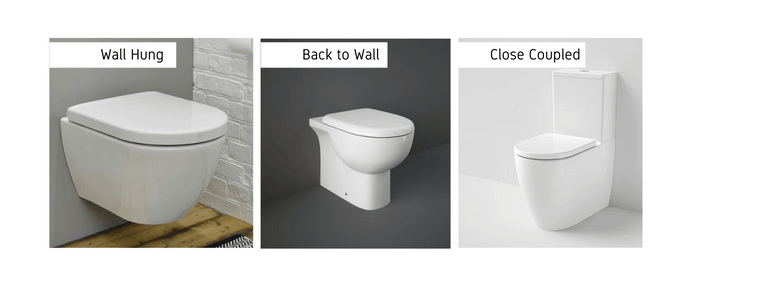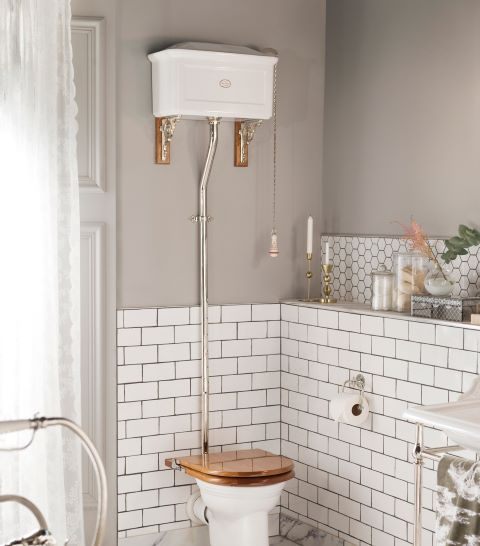What are the different toilet options?
When it comes to bathrooms, the humble toilet is anything but ordinary!. With SO many toilet options on the market now, it’s important to do your research and find the right one as it can make a big difference in how comfortable, not just aesthetically pleasing, your bathroom looks and feels.Our plumbers take a closer look at your toilet options…
What are the 3 main types of toilet?
Wall hung toilet
Wall hung toilets consist of a mounted frame in the wall which holds the cistern, concealing it behind the wall. The bowl is mounted to the wall, with a gap between it and the floor as there is no need for a base to stand on. The flush button will be installed on the wall above the toilet.
Pros:
- Can be installed at whatever height suits you
- Easy cleaning as there’s a gap between the bowl and floor
- Minimalist feel and the gap below gives the impression of more space; making them perfect for smaller bathrooms.
- Extremely quiet
Cons:
- More expensive that other types of toilets and the cost increases with the addition of electronic features, such as a heated seat
- Design, planning and installation considerations as the cistern is within the wall
- Not always easy to access the internal system for repair
For a more in depth analysis, visit our in-wall toilet pros and cons page
Back to wall toilet
A wall toilet is similar to a wall hung toilet in a sense that both only have the bowl aspect of the system visible. The cistern is concealed in the wall, but the back to wall toilet is attached to the ground, as opposed to appearing to float as the wall hung does.
Pros:
- Extremely quiet
- Easy to clean
- Can be installed in place of standard toilet due to having an “S trap” system (see below for more details regarding S and T traps)
Cons:
- Can be more difficult to access the internal system making repairs trickier and more costly
- Design, planning and installation considertions due to in-wall cistern
Close coupled toilet
Close coupled toilets are the most common and the style you are probably most acquainted with. They are a single, compact unit consisting of the cistern and pan; with the flush butter located on top of the cistern.
Pros:
- Quick and easy to install
- Cost effective
- Easy to use with the button on top of the cistern
- No changes are required to the plumbing to install, thereby reducing installation cost
- Can easily access the internal parts of the toilet for repairs and maintenance
- Extremely durable
Cons:
- Are rather plain compared to other types
- Sections joining the back and base tend to easily collects dirt and it can be difficult to clean
- Can take up more space

Positioning and height of toilets and cisterns
Corner toilets
When you have a particularly small space to work with, fitting a traditional toilet may not be feasible and this is where the corner toilet comes in. The same types are available, but not always simple to install due to the dimensions and placement of components in a corner shape.
Pros:
- Space saving
- Functional and fashionable
Cons:
- Must plan and measure to ensure use in comfort without shoulders or knees pressing on walls
- Complex installation as may require moving water pipes and drains
Comfort raised
A comfort raised toilet has a seat height of approximately 5cm higher than that of standard toilets.
Pros:
- Better for people with limited mobility and the elderly
- DDA compliant
- Don’t require the addition of a toilet raiser
Cons:
- More difficult for shorter people and children
- Feet can be left dangling, which can loss of circulation
- Heavier than standard toilets
High level
High level toilets are a way of winding back the years to the Victorian period, and perfect for a period-style decor bathroom. They consist of the cistern and bowl, as close coupled toilets do, but the cistern is installed in a raised position, high up the wall and there is a pipe connecting it to the bowl at floor level. There is a charming pull chain attached to the cistern, hanging down, which is pulled to flush.
Pros:
- Stunning, charming and a real feature piece in any home
- Makes bathroom bespoke
- Can customise the flush handle, toilet seats, pull chain etc to totally change the design of the toilet - No need to replace the whole system when changing the room’s colour scheme
Cons:
- More expensive
- Depends on bathroom size as with low ceilings or a small room you may struggle to fit one in
- Tend to use more water per flush than modern models

Low level
Low level toilets are standard toilets consisting of the cistern and bowl, which are connected by the flush pipe. The height of the pan is however, lower than the standard height by 100mm (standard - 400mm, low level 300mm from the floor).
They are extremely popular for many reasons:
Pros:
- Easy usage for children and help nurture bathroom independence
- Perfect for kindy, primary schools and kids camps
- Easy to replace; whether just the cistern or bowl and cistern
- Flexibility in positioning as flush pipe allows for some distance between the cistern and the bowl
- Easy access to the cistern for repairs
Cons:
- Difficult and not comfortable for adults to use
Other toilet factors to consider
Water efficiency
Toilets are rated using the Water Efficiency Labelling and Standards (WELS) system. It is certainly worth doing your research into the WELS rating when looking to purchase a toilet. Not only are more efficient toilets better for the environment but, you will also save money on your water bill. The WELS rating is shown as the number of stars achieved; 6 stars are the most efficient, so the more stars, the better!
Dual flush
The dual flush system was first developed in Australia to reduce water usage due to droughts. There are 2 buttons atop the cistern: one full flush using 6 litres of water and one for a partial flush using less than 3 litres. Considering the water usage of your home will be reduced by, on average, 30% per day and that dual flush toilets cost a similar amount to purchase, it's a no-brainer, right? The only possible downfall is that the lower end models have a reputation for leaking.
S & P trap
Trap systems are bends in the piping that are like a buffer between your living space and the smelly, hazardous gases of sewage. These bendy pipes ensure that dangerous pollutants such as carbon monoxide, methane, and nitrogen don’t make it into your home.
S traps are the older design of trap that you will probably have in your home if it is an older property and you haven’t altered the plumbing. S traps pretty much look exactly like the name suggests; an s-shape. This shape can eventuate with water syphoning, if it is not maintained. Water syphoning is when the water that is supposed to be blocking sewer gases, evaporates in the trap. Without the water in the trap, there’s nothing to stop the sewer gases reaching your bathroom. This is why the S trap is not recommended when installing new toilets. In fact, if you have an S trap, it is recommended to have a plumber replace it with a P trap at your earliest convenience (it is the law that only a licensed plumber can perform any work regarding sewerage, so no DIY).
Speak to the Pure Plumbing experts
When you are considering your new bathroom, contact us to discuss toilet style, placement and options that are suitable for your home. It is imperative that any toilet be installed and plumbed correctly so always use a licensed plumber.
